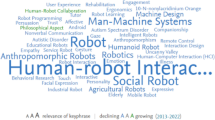Abstract
Motivation and emotions have been area of interest for philosophers, psychologists and neuroscientist. Researchers and scientists want to have human like intelligent robots which are self-aware and self-motivated. Motivational robots are autonomous and intelligent which can set goals and then take actions to achieve their goals independently. Moreover, intelligence in robots is not possible without autonomy and autonomy is incorporated in robots through motivation. Nowadays, attention is being paid to build robots which have computational and energy autonomy. In Literature, various motivational architectures have been presented but none seems to focus on the development of human inspired motivation in robots comprehensively. These architectures try to achieve mere functional motivation in limited way, some considered only time for the regulation of drives, others failed to incorporate physiological and psychological aspects of human motivation. To the best of our knowledge, no architecture is truly based on the physiology and psychology of humans has been considered in the literature. To solve this problem, this paper proposes a motivational architecture for autonomous robots to make them independent in deciding the goals and taking actions. The proposed architecture is primarily based on physiology and psychology of human motivation through basic human drives (hunger, thirst and sleep), emotions and glucose-insulin theories. The whole process of drives regulation is based on stimulation and satiation. The intensity of the drives and the emotional states help in setting the goal and accordingly a suitable action is taken to meet the particular goal. Empirical results show that glucose and insulin have direct relationship with basic drives and emotions in the process of intrinsic motivation generation. The proposed architecture has applications in industry, education and autonomous robots. The proposed motivational architecture has significant advantages over several state-of-the-art architectures in terms of autonomy through intrinsic motivation.










Similar content being viewed by others
Code availability
Code that supports the finding of this study is available from the corresponding author, upon reasonable request.
References
Ardakani MMG (2012) An Overview of “Developmental Robotics”. Lund University Archives, Sweden
Konidaris G 2006 An adaptive robot motivational system. In: International Conference on Simulation of Adaptive Behavior, Springer, Berlin, pp 346–356
Manzotti R, Tagliasco V (2005) From behaviour-based robots to motivation-based robots. Robot Autonom Syst 51(2–3):175–190
Franklin S, Ramamurthy U (2006) Motivations, Values and Emotions: 3 sides of the same coin. Paper presented at the Sixth International Workshop on Epigenetic Robotics, Paris, France, September 2006
Cañamero D Modeling motivations and emotions as a basis for intelligent behavior. In: first international conference on Autonomous agents, 1997 Feb 8. pp 148–155
Velásquez JD When robots weep: emotional memories and decision-making. In: AAAI/IAAI, 1998 Jul 1. pp 70–75
Breazeal C A motivational system for regulating human-robot interaction. In: Aaai/iaai, Wisconsin, 1998. pp 54–62
Breazeal C SB How to build robots that make friends and influence people. In: IEEE/RSJ International Conference on Intelligent Robots and Systems. Human and Environment Friendly Robots with High Intelligence and Emotional Quotients, 1999 Oct 17. IEEE, pp 858–863
Cotterill R (2003) Cyberchild a simulation test-bed for consciousness studies. J Conscious Stud 10(4–5):31–34
Stoytchev AAR (2004) Incorporating motivation in a hybrid robot architecture. J Adv Comput Intell 8(3):269–274
Sun R (2009) Motivational representations within a computational cognitive architecture. Cognit Comput 1(1):91–103
Jin Y, Meng Y (2011) Morphogenetic robotics: an emerging new field in developmental robotics. IEEE Trans Syst, Man, Cybern, Part C (Appl Rev) 41(2):145–160
Baranes A, Oudeyer P-Y (2013) Active learning of inverse models with intrinsically motivated goal exploration in robots. Robot Autonom Syst 61(1):49–73
Bach J Modeling Motivation in MicroPsi 2. In: International conference on artificial general intelligence, Jul 22 2015. Springer, Cham, pp 3–13
Rodriguez-Lera FJ, Matellan-Olivera V, Conde-Gonzalez MA, Martin-Rico F (2018) HiMoP: a three-component architecture to create more human-acceptable social-assistive robots : motivational architecture for assistive robots. Cogn Process 19(2):233–244
Giovanni Pacini RNB (1986) MINMOD: a computer program to calculate insulin sensitivity and pancreatic responsivity from the frequently sampled intravenous glucose tolerance test. Comput Methods Programs Biomed 3(2):113–122
Saad MFAR, Laws A, Watanabe RM, Kades WW, Chen YD, Sands RE, Pei D, Savage PJ, Bergman RN (1994) A comparison between the minimal model and the glucose clamp in the assessment of insulin sensitivity across the spectrum of glucose tolerance. Diabetes 43(9):1114–1121
Steil GMVA, Kahn SE, Bergman RN (1993) Reduced sample number for calculation of insulin sensitivity and glucose effectiveness from the minimal model: suitability for use in population studies. Diabetes 42(2):250–256
Funding
This study is not funded by anyone.
Author information
Authors and Affiliations
Contributions
All authors have equal contribution.
Corresponding author
Ethics declarations
Conflict of interest
The authors declare that they have no conflict of interest.
Ethical approval
This article does not contain any studies with human participants or animals performed by any of the authors.
Rights and permissions
About this article
Cite this article
Khan, A.S., Anwar, A.A. & Azeem, K. Bio-inspired motivational architecture for autonomous robots using glucose and insulin theories. Evol. Intel. 14, 2039–2050 (2021). https://doi.org/10.1007/s12065-020-00489-3
Received:
Revised:
Accepted:
Published:
Issue Date:
DOI: https://doi.org/10.1007/s12065-020-00489-3




